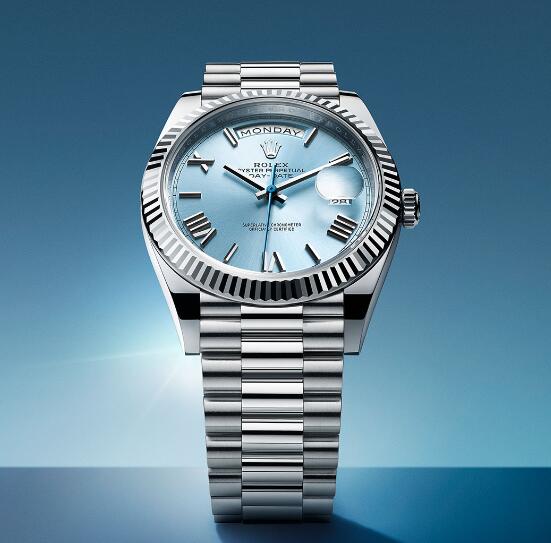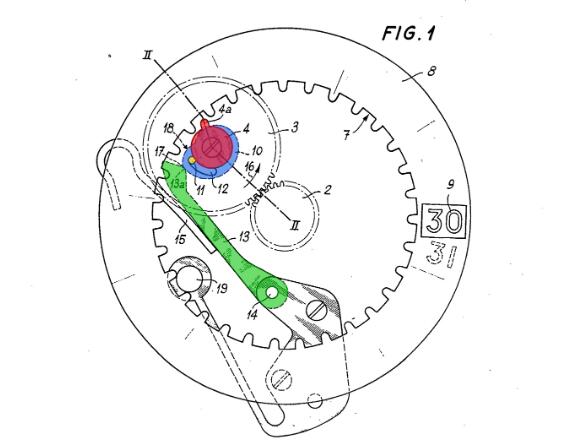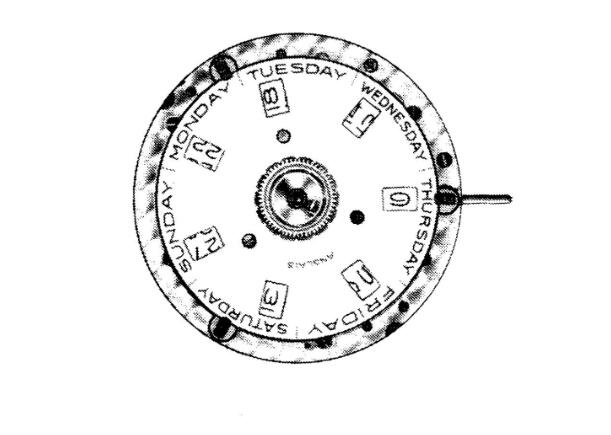Arguably the most prestigious Rolex wristwatch, the Swiss made Rolex Oyster Perpetual Day-Date replica watches was introduced in 1956 and has only ever been available in precious metals – with the exception of a handful of prototypes in stainless steel.

From its beginnings the UK perfect fake Rolex Day-Date watches had a particular significance in the Rolex catalogue. The brand’s advertising from the 1960s for the Day-Date carried the phrase “Men who guide the destinies of the world of the world wear Rolex watches”. It was also during this time that the now-familiar “President” nickname for the model emerged when American president Lyndon Johnson, along with several of his successors, were photographed wearing luxury Rolex Day-Date copy watches.
The Day-Date was the first wristwatch to indicate the date as well as day of the week spelled out in full, a technical feat at the time. In the near-seven decades since, the AAA online replica Rolex Day-Date watches has remained consistent in terms of design and function: the date sits in a window at three o’clock, while the day is displayed within the arc-shaped window at 12 o’clock.

Though the dial layout has stayed the same, the mechanics behind the display have been refined and improved substantially over the years. Today’s models – namely the Day-Date 36 and Day-Date 40 – are powered by the cal. 3255. The movement boasts all of Swiss 1:1 Rolex super clone watches‘ technical innovations, along with a double instantaneous calendar display, where both the date and day indicators jump instantaneously and simultaneously at midnight.
The cal. 3255 is part of the latest-generation calibre 32XX family of movements underpinning the Oyster Perpetual collection, which also includes the cal. 3285 in the GMT-Master II and cal. 3235 in the China 2024 Rolex Deepsea replica watches.
As such, the cal. 3255 boasts all the features of a modern Rolex movement: a rotor mounted on ball bearing races, a paramagnetic blue Parachrom hairspring, the energy-efficient Chronergy escapement, and a comfortable power reserve of approximately 70 hours, or three days.
While many of these innovations are well known – we already covered Chronergy in-depth – the “Perpetual rotor” automatic winding system of the calibre 32XX family often goes unnoticed. Apart from a redesigned rotor that’s more robust and efficient thanks to an upgraded bearing, the entire automatic winding train has been subtly tweaked.
The classic Perpetual rotor automatic system with reverser-winding has proved its worth over time. Already regarded as one of the best winding systems in watchmaking, the Perpetual rotor was redesigned in keeping with top Rolex fake watches‘ well-known engineering-driven approach to incremental innovation that gradually optimises and refines over time.
Among other things, the recognisable pair of red reversing wheels have been replaced with an optimised version. While earlier-generation wheels were entirely coated in a low-friction material similar to Teflon, the new reversing wheels feature only a thin band of red coating along their circumference, presumably where friction wear is the greatest.
Doing away with the full coating on the reversing wheels improves winding efficiency by reducing the weight of the winding train, since the coating itself adds weight to the wheels. The winding train in any automatic wholesale Rolex replica watches is frequently subject to high operating speed and sudden changes of direction, so lighter gears are always preferable from a mechanical perspective.
Another factor is thinness: the redesigned reversing wheels are mounted in an inverted position compared to their predecessors, which reduces the overall height of the winding train. As the redesigned rotor hub is thicker than its predecessor, the new reversing wheels allow the entire movement to remain relatively slim.
A clever calendar
The first-ever Day-Date movement was patented in 1955 (with Swiss patent CH323982A), a year before the launch of the China Rolex Day-Date copy watches at the Basel Fair of 1956. As a result, all Day-Date calibres end in “55”, from the inaugural cal. 1055, followed by cal. 3055, cal. 3155, and finally today’s cal. 3255. (Interestingly, Rolex filed a patent for a day-and-date display in 1950 with United States patent US2591819A, indicating the concept was refined over several years.)
Since the beginning, the Day-Date movement featured an instantaneous date and day display. While the day indication is unique to this model, the instant-change date has since become a hallmark of almost all Rolex movements.
Conventional date mechanisms rely on a date disc that advances one step every 24 hours, driven forward by a finger at midnight. Because the date disc needs sufficient clearance in order to work properly, the finger starts to engage the date disc well before midnight and then only completes the date change sometime after midnight.
Depending on the movement, a date change might take up to an hour to complete, a time during which the date disc slowly creeps forward in the date window. Apart from the unappealing visual of the space between two dates showing in the date window, such conventional date mechanisms can be inconvenient for the wearer, since setting the date during the changeover can damage the date change system.
Invented in the early to mid 1950s by Rolex engineer Marc Huguenin and described in Swiss patent CH322341A of 1955, the Rolex instant-change date mechanism was a clever technical solution that has remained largely unchanged to this day; the date mechanism in current generation Rolex movements continue to operate on the same fundamental principles.
Notably, the clever system operates in a somewhat similar fashion to a remontoir, the spring-driven constant-force mechanism found in precision clocks and Rolex replica watches shop.

As illustrated in Fig. 1, the instant-change system has a 24-hour wheel 3 which carries the switch finger 4a. The two are connected in such a way that the finger can rotate within a fixed arc independently from wheel 3. Under wheel 3, and rigidly connected to the finger, is a cam 10. On that cam acts a tensioning arm 13. Cam 10 has a pin 11 which fits in a cut-out sector 12 in wheel 3. With this set up, the wheel and finger are connected while maintaining a degree of freedom of motion relative to each other.
Over the course of a day, the 24-hour wheel and finger turn as one. Sometime during the late evening the profile of cam 10 starts rising against tensioner 13. Because of the resistance applied by the tensioner, the finger and cam remain in place, while wheel 3 keeps rotating. At some point the cut-out sector banks into pin 11, thus making the cam-finger assembly advance as well.
Right around midnight, finger 4a is in close proximity to one of the teeth of the date disc. The tensioner is cocked back at the highest point of cam 10. As the 24-hour wheel slowly advances, the cam moves fractionally past its highest point, which prompts the tensioner to swiftly push and accelerate the cam and finger as far as sector 12 allows.

The action is very much like a chronograph resetting. The finger and cam carry along with them the date disc, thus advancing the date in a fraction of a second. Just like a remontoir, the system breaks the continuous connection between the train and switch finger. Unlike a remontoir, the date system slowly charges and then swiftly discharges. The opposite happens in a remontoir, which swiftly charges, then slowly discharges.
Apart from the crisp (and audible) show of precision mechanics when the date changes, the system also allows the user to set the date at will – at any time, even midnight – since there is no prolonged engagement between the date disc and switch finger.
The fundamental principle behind the instantaneous date in turn form the basis of the instantaneous day display in the high quality fake Rolex Day-Date watches. In the Day-Date movement, the instant day indicator exploits the swift jump of the date finger to change the day indication as well.
In the Day-Date display, a second finger is added to the cam-finger mobile and engages a gear shaped like a column wheel that is set co-axially with the cannon pinion for the hands. A large day-of-the-week disc is fitted over the column-wheel gear and jumps along with it. The column-wheel gear has seven wide teeth with flat tops – one for each day of the week – meaning each instantaneous jump of the day disc requires a 1/7th rotation.
Because the day disc is so large, almost the full diameter of the cover, it nearly covers the date disc entirely. As a result, the day disc has seven apertures evenly spaced in such a way that regardless of the day shown at 12 o’clock, the correct date numeral is always visible through the window at three o’clock.
The dial is fitted over the double-disc arrangement, creating the illusion that the two discs coexist on the same plane for the wearer.
As with the original date display, the day-and-date display is equally convenient to set.
While the two discs change instantaneously in sync at midnight, they can be quick-set independently by turning the crown in either direction. This can be done at any time, thanks to the foolproof construction of the mechanism. In typical Rolex fashion the day-date simple complication is done smartly, with reliability and convenience in mind.
It is illustrative of the online UK Rolex replica watches way that the brand has relied on an instantaneous calendar that can be set at any time for decades now, but in contrast, most contemporary automatic movements today still employ date mechanisms that must be set outside of the changeover period.

